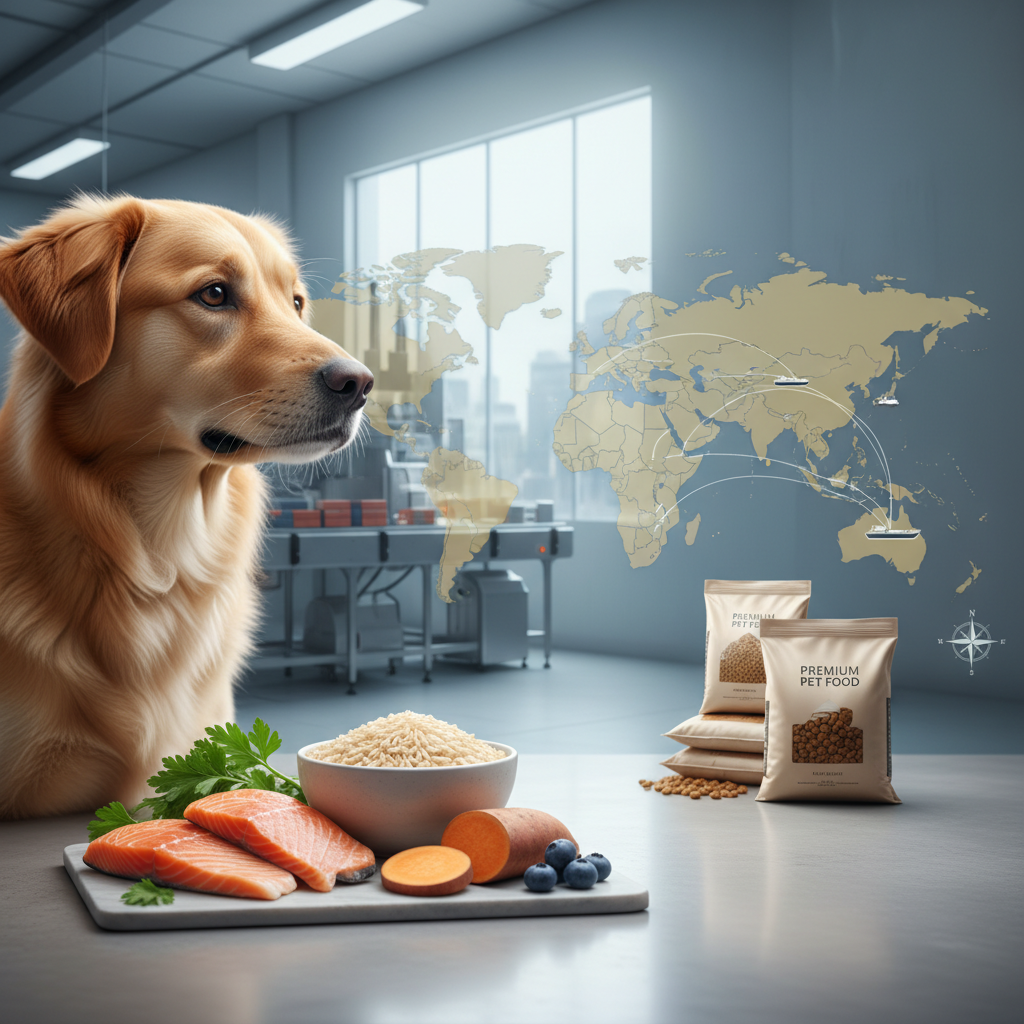

Introduction: Unlocking the Lucrative Southeast Asian Dog Food Market
The global pet food industry is experiencing unprecedented growth, and nowhere is this more evident than in Southeast Asia. This vibrant and dynamic region, encompassing diverse economies from Singapore to Vietnam, is rapidly emerging as a critical market for dog food manufacturers, exporters, importers, and private label brand owners. With increasing disposable incomes, a growing middle class, and the deeply ingrained trend of pet humanization, dogs are no longer just animals; they are cherished family members, leading to a surge in demand for high-quality, nutritious, and specialized dog food products. For B2B stakeholders – whether you are a seasoned manufacturer looking to expand your reach, a distributor seeking premium products, or an entrepreneur eyeing private label opportunities – understanding the nuances of the Southeast Asian dog food market is paramount. This comprehensive guide will equip you with the insights and actionable strategies needed to navigate this complex yet incredibly rewarding landscape. We'll delve into market trends, regulatory considerations, supply chain optimization, and the burgeoning private label sector, ensuring your business is well-positioned for success in one of the world's most exciting pet food markets.
Understanding the Southeast Asian Dog Food Market Landscape
The Southeast Asian region presents a tapestry of diverse cultures and economies, yet a common thread of escalating pet ownership and a willingness to invest in pet wellness binds them.
Key Market Trends and Consumer Behavior
The demand for dog food in Southeast Asia is characterized by several overarching trends:
- Premiumization and Humanization: Pet owners are increasingly treating their dogs like children, leading to a strong demand for premium, natural, organic, and human-grade ingredients. Products boasting specific health benefits (e.g., joint support, skin and coat health, digestive aid) are highly sought after.
- Health and Wellness Focus: There is a growing awareness of canine nutrition and its impact on longevity and quality of life. This drives demand for specialized diets, including grain-free, limited ingredient, and breed-specific formulations.
- E-commerce Boom: Online retail platforms are a significant distribution channel across Southeast Asia, offering convenience and a wide selection to consumers. A strong digital presence is crucial for market penetration.
- Local Preferences and Breed Specificity: While global trends influence the market, local preferences remain vital. For instance, smaller dog breeds are common in urban areas, leading to demand for appropriate kibble sizes and formulations. Protein sources can also be a point of differentiation, with unique offerings gaining traction.
- Sustainability and Ethical Sourcing: A nascent but growing segment of consumers is concerned with the environmental impact and ethical sourcing of ingredients. Brands that can demonstrate transparency and commitment to sustainability may gain a competitive edge.
Regulatory Frameworks and Import Requirements
Navigating the regulatory landscape is perhaps one of the most critical aspects of exporting dog food to Southeast Asia. Each country within the ASEAN bloc – including powerhouses like Thailand, Vietnam, Indonesia, the Philippines, Malaysia, and Singapore – possesses its own specific import regulations, labeling standards, and veterinary health requirements. Common requirements often include:
- Veterinary Health Certificates: Issued by the exporting country's animal health authority, certifying that products are free from diseases and fit for consumption.
- Ingredient Restrictions: Certain ingredients may be prohibited or restricted, necessitating careful formulation adjustments.
- Labeling Requirements: Mandating specific information such as ingredient lists, nutritional analysis, country of origin, manufacturing date, expiry date, and feeding instructions, often in the local language.
- Registration and Licensing: Importers or products may need to be registered with local agricultural or veterinary departments.
- Product Testing: Random or mandatory testing for contaminants or specific pathogens.
It is crucial for exporters and importers to conduct thorough due diligence for each target market to ensure full compliance, avoiding costly delays and potential product recalls. Partnering with experienced local importers or consultants can significantly streamline this process.
Building a Robust Export Strategy for Dog Food
A successful entry into the Southeast Asian market requires more than just a great product; it demands a meticulously planned and executed export strategy.
Market Research and Niche Identification
Before committing resources, undertake comprehensive market research. Identify countries with the highest growth potential, understand the competitive landscape, and pinpoint underserved niches. Are consumers looking for specific protein alternatives? Is there a gap in specialized diets for senior dogs or puppies? Could novel protein sources like buffalo meat or buffalo Omasum, known for their nutritional value, be a unique selling proposition if compliant with local regulations and market acceptance? Analyzing distribution channels – from large hypermarkets to specialized pet stores and the burgeoning e-commerce platforms – will also inform your strategy. Don't underestimate the power of local data and insights to tailor your offerings.
Supply Chain Optimization for International Trade
An efficient and resilient supply chain is the backbone of successful international trade. For dog food, this involves several critical components:
- Raw Material Sourcing: Establish reliable and traceable sources for all ingredients. Quality control starts here. If exploring options like buffalo meat or Omasum, ensure your suppliers meet international hygiene and ethical standards. Consistency in supply and quality is non-negotiable.
- Manufacturing and Production: Maintain stringent quality control (QC) and quality assurance (QA) processes throughout production. Adherence to international standards such as HACCP, GMP, or ISO certifications builds trust and facilitates regulatory compliance.
- Logistics and Freight: Determine the most cost-effective and efficient shipping methods (sea freight for bulk, air freight for speed). Consider transit times, temperature control requirements (especially for wet food or specific ingredients), and customs clearance procedures. Work with experienced freight forwarders who specialize in pet food or perishable goods and have strong networks in Southeast Asia.
- Inventory Management: Implement robust inventory systems to manage stock levels effectively, reducing waste and ensuring timely delivery to your distributors.
Optimizing these elements minimizes costs, reduces lead times, and enhances product integrity upon arrival.
Quality Assurance and Compliance
Maintaining the highest standards of quality is not just a regulatory requirement but a fundamental business imperative. In a market increasingly focused on pet health, consumers and B2B partners alike demand assurances of product safety and efficacy.
- Certifications: Beyond basic regulatory compliance, obtaining internationally recognized certifications (e.g., FDA compliance for ingredients, EU certifications for certain processes, or specific country-level approvals) can significantly enhance your brand's credibility.
- Traceability: Implement a robust traceability system from raw material sourcing through to final product distribution. This allows for quick identification and recall if issues arise, protecting your brand reputation.
- Packaging Integrity: Ensure packaging is robust enough to withstand the rigors of international shipping and diverse climatic conditions in Southeast Asia. Proper sealing and material choice are vital for maintaining freshness and preventing contamination. Bilingual or multi-language labeling may be required, so plan for accurate translations.
Navigating Private Label Opportunities in Southeast Asia
The private label sector within the pet food industry is booming globally, and Southeast Asia is no exception. This presents a unique strategic avenue for both manufacturers looking to expand their production capacity and distributors/importers seeking to establish their own brand identity.
The Rise of Private Label Pet Food
For importers, distributors, and wholesalers, private labeling offers significant advantages:
- Higher Margins: By eliminating national brand marketing costs and leveraging efficient manufacturing, private label products often yield better profit margins.
- Brand Control and Differentiation: It allows you to create a unique brand story, tailor products to specific local market needs, and build customer loyalty under your own name.
- Market Responsiveness: Private label can offer greater flexibility to react quickly to market trends and consumer demands with new formulations or packaging.
For manufacturers, offering private label services means:
- Capacity Utilization: Maximizing production capacity and diversifying revenue streams beyond their own brand.
- Market Expansion: Gaining indirect access to new markets through strong local partners without the extensive investment in brand building or distribution networks.
- Expertise Leverage: Utilizing their formulation and manufacturing expertise for a wider client base.
Key Considerations for Private Label Partnerships
When pursuing or offering private label dog food in Southeast Asia, consider these crucial aspects:
- Ingredient Sourcing Flexibility: A strong private label manufacturer should offer a wide array of high-quality ingredients. This includes standard proteins like chicken and beef, but also allows for exploration of unique or regionally preferred options. For instance, can they incorporate ethically sourced buffalo meat or buffalo Omasum, which are increasingly recognized for their nutritional benefits and novel protein status, if compliant with local regulations and market acceptance?
- Formulation Expertise: The ability to develop custom formulations tailored to specific nutritional profiles, breed sizes, or health conditions is a significant asset. This ensures the private label product genuinely meets a market need.
- Packaging Design and Branding Support: Look for partners who can offer support in packaging design, material selection, and adherence to local labeling regulations. A manufacturer who understands branding can be invaluable.
- Minimum Order Quantities (MOQs): Understand the manufacturer's MOQs and how they align with your business model and market entry strategy. Flexible MOQs can be beneficial for testing new products or entering smaller markets.
- Confidentiality and IP Protection: Ensure robust agreements are in place to protect your intellectual property, formulations, and market strategies.
Actionable Steps for B2B Success: Your Export Checklist
Embarking on the journey to export dog food to Southeast Asia requires a systematic approach. Use this checklist to guide your strategic planning and execution:
- Define Your Target Market(s): Select 1-3 initial countries within Southeast Asia. Conduct in-depth market research to understand local demand, competition, consumer demographics, and economic indicators.
- Master Regulatory Compliance: Thoroughly research and understand the specific import regulations, labeling laws, veterinary health certificates, and ingredient restrictions for each target country. Engage local legal or regulatory experts if necessary.
- Forge Strategic Partnerships: Identify and vet reliable local importers, distributors, or agents. Look for partners with established networks, strong market knowledge, and a commitment to quality. For private labeling, select a manufacturing partner with proven expertise, flexibility in ingredient sourcing (e.g., ability to work with novel proteins like buffalo meat/Omasum if desired), and robust quality control.
- Optimize Your Product Portfolio: Adapt your formulations and packaging to meet local preferences, nutritional needs, and regulatory requirements. Consider introducing specialized diets or unique protein sources that resonate with the target market.
- Build a Resilient Supply Chain: Establish strong relationships with raw material suppliers, ensuring consistent quality and traceability. Partner with experienced logistics providers for efficient, compliant, and cost-effective international shipping.
- Implement Robust Quality Assurance: Maintain internationally recognized certifications (HACCP, ISO, GMP) and conduct rigorous internal quality checks throughout the production and supply chain.
- Develop a Targeted Marketing and Sales Strategy: For B2B, this includes participating in industry trade shows, engaging in targeted digital marketing, and developing compelling sales collateral that highlights your product's unique selling points and compliance.
- Plan for After-Sales Support: Ensure mechanisms are in place for addressing inquiries, feedback, and potential issues from your B2B partners and, ultimately, the end consumers.
Conclusion: Paving Your Way to Prosperity in the Pet Food Sector
The Southeast Asian dog food market presents an expansive horizon of opportunities for discerning B2B players. From the bustling metropolises to the rapidly developing secondary cities, the region's increasing affection for canines translates directly into a robust and growing demand for high-quality, nutritious dog food. By meticulously understanding the market dynamics, diligently navigating regulatory complexities, optimizing your supply chain, and strategically leveraging private label opportunities, your business can establish a strong and profitable presence. Success in this dynamic market hinges on strategic planning, unwavering commitment to quality, and the cultivation of strong, trustworthy partnerships. Embrace the challenge, and you will find Southeast Asia to be a highly rewarding frontier for your dog food enterprise.
Ready to explore how your dog food products or private label ambitions can thrive in the Southeast Asian market? Contact us today to discuss your specific needs and discover tailored solutions for your business.


